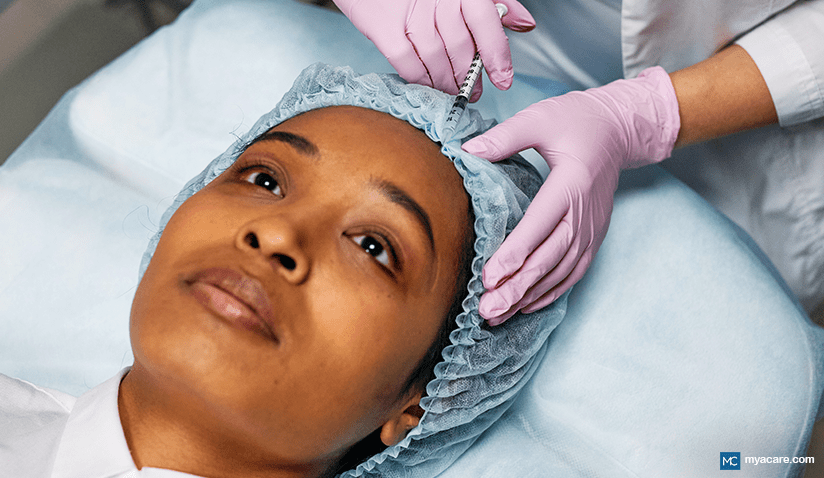BOTOX VS. DERMAL FILLERS

Botox injections and dermal fillers are, without any doubt, the two most popular non-invasive aesthetic treatments nowadays. They owe popularity to their simplicity, safety, and effectiveness, among other things. Both procedures tackle common signs of skin aging, such as wrinkles and saggy skin. But, there are some significant differences between them.
These differences are not always thoroughly understood by patients. Which sometimes makes it difficult to manage their expectations. The purpose of this article is to explain the distinctive uses of Botox and dermal fillers in aesthetic medicine and anti-aging. So, the readers can understand their full potential.
Overview
Non-invasive and minimally invasive cosmetic procedures, such as Botox and dermal fillers, aim to deliver highly satisfying aesthetic results with a lower risk of complications, lower cost, and without downtime. As such, they are popular alternatives to plastic surgery.
Both Botox and dermal fillers primarily improve age-related facial skin issues. These include loss of skin volume, fine lines, wrinkles, thin lips, lack of jawline definition, and so on. However, the two procedures work in different ways. They also attend to different areas of the face and complement each other to a certain extent.
To better understand all the advantages and disadvantages of these non-invasive beauty treatments, we first need to know what they are.
What is Botox?
Botox® is a brand name for botulinum toxin. Other popular brands include Dysport, Vistabel, Bocouture, and Xeomin. Botulinum toxin is a neurotoxic protein. It is a product of the bacterium Clostridium botulinum. It is a highly toxic substance with muscle-paralyzing ability. That ability is the source of its wrinkle-erasing power. When relaxed facial muscles get injected with small doses of botulinum toxin, those muscles become temporarily paralyzed. That inhibits the unwanted facial expressions, such as frowning, responsible for the creation of wrinkles.
Botulinum toxin does not stop the aging process. Nor does it help skin rejuvenation in any way. It only makes certain parts of the skin look better. However, the effects of botulinum toxin injections are temporary. They wear off after three to six months. After that time, the injected muscles regain their full function, and wrinkles slowly reappear.
The Use of Botox in Aesthetic Medicine
Botulinum toxin injections work best in the upper third of the face. They help improve or erase fine lines and wrinkles on the forehead and around the eyes.
Main indications for the use of Botulinum toxin in aesthetic medicine are:
- Horizontal forehead lines
- Frown lines
- Crow's feet
- Facial asymmetry
- Vertical lip lines
- Masseter lines
- Chin dimpling
- A gummy smile, and
- Bunny lines
Lack of volume in the lips, cheeks, and jawline or nasolabial folds is not treatable with Botox injections. The main advantages of this procedure are quickly visible results and the lack of need for anesthetics or hospital stay.
Potential Side Effects
Botulinum toxin injections are relatively safe if they are administered in a controlled environment by trained professionals. Only aesthetic medicine specialists, dermatologists, and primary care physicians with adequate knowledge of injection techniques and facial anatomy should conduct the treatment.
Usually, patients only feel minor discomfort at injection sites during the procedure. After the treatment, some swelling, redness, and tenderness can occur. However, these are normal unless they last longer than three to seven days.
Severe complications are rare. These are usually a consequence of a poorly conducted procedure, allergies, infections, and so on. Such complications may include:
- Facial asymmetry
- Eyelid drooping
- Headache
- Numbness or weakness of nearby muscles, and
- Flu-like symptoms
What are dermal fillers?
Like Botox, dermal fillers are injectable substances. However, they do not affect the functioning of muscles or any other tissues. Instead, dermal fillers add volume to certain areas of the face. They fill out creases and deeper wrinkles, increase the size of lips, improve jawline definition, and so on.
There are several types of dermal fillers. The most popular ones are:
- Hyaluronic acid
- Collagen
- Calcium hydroxylapatite
- PLLA (Poly L-Lactic Acid)
- PMMA (Polymethylmethacrylate beads)
Each type has specific characteristics. They are made of different materials and deliver different aesthetic results. Some also last longer than others.
Dermal Fillers in Cosmetic Procedures
Dermal fillers are a non-invasive aesthetic procedure with reconstructive potential. Their application restores lost volume and adds definition to the chin, cheeks, lips, nasolabial folds, eye bags, etc. Therefore, fillers can often be a more affordable and less complicated alternative to plastic surgery. After placement under the skin, dermal filler spreads out in the treated area evenly. It adds volume to any depressions, smoothens fine lines and wrinkles, and restores a more youthful appearance to the skin.
Common indications for dermal filler are:
- Marionette lines (smile lines)
- Sunken cheeks
- Thin lips
- Chin crease
- Vertical lip lines
- Facial asymmetry
- Lack of jawline definition
Chin fillers are possibly the best example of the non-invasive reconstructive potential of dermal fillers, in general. By correctly placing the filler in the chin area, it is possible to significantly change the profile and give more projection to the lower part of the face without surgery. That eliminates the need for chin implants, lengthy recovery, and potential complications such as pain, scarring, and infections.
Together with jawline, lip, and cheek fillers, this procedure can effectively change the definition of the patient's facial contours in a more natural-looking way.
Side Effects
Dermal fillers are generally safe. Some side effects, such as bruising, swelling, redness, and pain, are considered normal. These usually resolve within one or two weeks following the procedure.
The appearance of lumps, bumps, and skin discoloration is also possible. But, more severe complications, such as infections, blurred vision, or blindness, usually occur due to inadequate injection techniques by poorly trained personnel in a non-sterile environment.
The Bottom Line
Both Botulinum toxin injections and dermal fillers can be a quality solution for mild and moderate facial skin issues. Due to their simplicity and lack of downtime, the two procedures can take place simultaneously. Botox in the upper third and filers in the middle and lower sections of the face - to achieve the maximum cosmetic effect.
To search for the best Plastic & Cosmetic Surgery healthcare providers in Croatia, Germany, Greece, India, Malaysia, Singapore, Slovakia, Spain, Thailand, Turkey, Ukraine, the UAE, the UK and the USA, please use the Mya Care search engine.
Sources
- Farolch-Prats L, Nome-Chamorro C. Facial Contouring by Using Dermal Fillers and Botulinum Toxin A: A Practical Approach. Aesthetic Plast Surg. 2019 Jun;43(3):793-802. doi: 10.1007/s00266-019-01361-1. Epub 2019 Apr 5. PMID: 30953112; PMCID: PMC6522458.
- Satriyasa BK. Botulinum toxin (Botox) A for reducing the appearance of facial wrinkles: a literature review of clinical use and pharmacological aspect. Clin Cosmet Investig Dermatol. 2019 Apr 10;12:223-228. doi: 10.2147/CCID.S202919. PMID: 31114283; PMCID: PMC6489637.
- Chen S, Long J. [Adverse events of botulinum toxin A in facial injection: Mechanism, prevention and treatment]. Zhong Nan Da Xue Xue Bao Yi Xue Ban. 2019 Jul 28;44(7):837-844. Chinese. doi: 10.11817/j.issn.1672-7347.2019.190069. PMID: 31413225.
- Funt D, Pavicic T. Dermal fillers in aesthetics: an overview of adverse events and treatment approaches. Clin Cosmet Investig Dermatol. 2013 Dec 12;6:295-316. doi: 10.2147/CCID.S50546. PMID: 24363560; PMCID: PMC3865975.
Disclaimer: Please note that Mya Care does not provide medical advice, diagnosis, or treatment. The information provided is not intended to replace the care or advice of a qualified health care professional. The views expressed are personal views of the author and do not necessarily reflect the opinion of Mya Care. Always consult your doctor for all diagnoses, treatments, and cures for any diseases or conditions, as well as before changing your health care regimen. Do not reproduce, copy, reformat, publish, distribute, upload, post, transmit, transfer in any manner or sell any of the materials in this blog without prior written permission from myacare.com.



